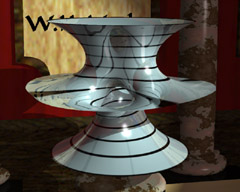|
|
Touching Soap Films |
|
|
|
Mathematical Visualization
Even for mathematicians it is not always sufficient to think only about abstract spaces and answer theoretical questions, they too need intuition for ideas, and they need confirmation of their conjectures which may come through practical experiments. Many questions in minimal surface theory come from experiments with soap films, for example from the experiments of the famous mathematician Courant and the physicist Plateau. In spite of their usefulness, such experiments must be restricted to relatively simple questions because of the lack of stability of soap films. As in many other areas, computer technology and state-of-the-art visualization techniques led to new insight and spectacular breakthroughs. These new tools enabled researchers to work experimentally with perfect artificial soap films in virtual environments. New methods and techniques in mathematical visualization are responsible for the enormous development during recent years. Within this development are discrete geometric descriptions of surfaces and their curvature properties, as well as visualization methods and new software environments for interactive mathematical experiments. In recent years it has become possible to enlarge the family of minimal surfaces considerably. We have learned how to construct new unbounded surfaces aimed at chosen geometrical shapes and also how to alter known surfaces. These new examples and especially their computer graphics images have in turn led to a better understanding of the geometry of general minimal surfaces and their underlying principles. They have also called attention to the structure of these surfaces in other scientific disciplines like crystallography and polymer chemistry. And not only do the images have aesthetic charm, they also serve as intuitive material for teaching and as aids to understanding for scholars in the discussion of new phenomena. |
